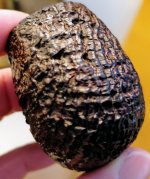Oh yes, it sure is.Other than the very minor crack it is a lovely pipe.
The blast is to die for .
Oh yes, it sure is.Other than the very minor crack it is a lovely pipe.
I don't know why it took me so long to get that.My bad, shank of course.
Sorry all , stupid me.
Thank you, not a clue why it took me so long either.I don't know why it took me so long to get that.
Ken Barnes often spoke of how (via Barry Jones I assume) Reuben Charatan would send pipes out for sandblasting to a neighborhood glass/window shop with a note to go "heavy on the bowls, light on the shanks".
Later, Ken would attribute the same quotation to Reuben as his directions toward the in-house sandblaster (Tony or Tom or Joe).
Could have been a lapse in memory or just a mantra at Charatan - Heavy on the bowls, light on the shanks!
Hello Brian,I don't know why it took me so long to get that.
Ken Barnes often spoke of how (via Barry Jones I assume) Reuben Charatan would send pipes out for sandblasting to a neighborhood glass/window shop with a note to go "heavy on the bowls, light on the shanks".
Later, Ken would attribute the same quotation to Reuben as his directions toward the in-house sandblaster (Tony or Tom or Joe).
Could have been a lapse in memory or just a mantra at Charatan - Heavy on the bowls, light on the shanks!
The fingertips of Ken Barnes.Hello Brian,
Where does your info derive from ?
Cheers,
Roland
Not really helpful, but thank youThe fingertips of Ken Barnes.
I don't know how else to say it.Not really helpful, but thank you
I have a sandblasted Charatan with a rusticated shank. I read online that the reason was Dunhill's patent on sandblasting.
So maybe they couldn't sandblast a pipe entirely.
Over here we still refer to the shank as being the stem and to the stem as the mouthpiece.
Like in the old days. Savvy ?
I like the finish on this one a lot.Like the OP, Charatans are typically too large for my taste.
I did own this smaller 109, this finish looks more rusticated than sandblasted, or at least a combination of the two. Right?
View attachment 306398
View attachment 306400
Suppose it is only semantics, but it makes more sense to me .This is quite true, and in America at least relatively unknown. I’ve read a great deal of 1920s testimony by UK industry leaders that used stem to refer to what we now generally call shank.









